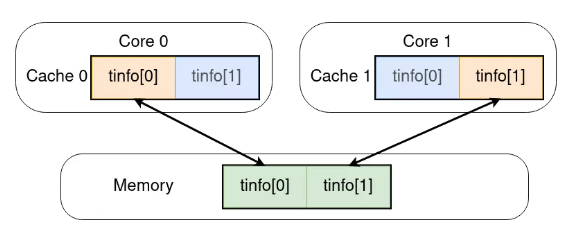超線程Smt究竟可以快多少?(斐波那契版)
宋老師的SMT測試很有意思,但是編譯內核涉及的因素太多了,包括訪問文件系統等耗時受到存儲器性能的影響,難以估算,因此很難評判SMT對性能的提升如何。
為了探究SMT對計算密集型workload的效果,我自己寫了一個簡單的測試程序。
使用pthread開多個線程,每個線程分別計算斐波那契數列第N號元素的值。每個線程計算斐波那契數列時除線程的元數據外只分配兩個unsigned long變量,由此避免過高的內存開銷。
workload的詳細代碼和測試腳本在[https://github.com/HongweiQin/smt_test]
毫無疑問,這是一個計算密集型負載,我在自己的筆記本上運行,配置如下(省略了一些不重要的項目):
- $ lscpu
- Architecture: x86_64
- CPU(s): 12
- On-line CPU(s) list: 0-11
- Thread(s) per core: 2
- Core(s) per socket: 6
- Socket(s): 1
- NUMA node(s): 1
- Vendor ID: GenuineIntel
- Model name: Intel(R) Core(TM) i7-9750H CPU @ 2.60GHz
- L1d cache: 192 KiB
- L1i cache: 192 KiB
- L2 cache: 1.5 MiB
- L3 cache: 12 MiB
可以看到筆記本有一個Intel i7的處理器,6核12線程。經查,CPU0和CPU6共用一個Core,CPU1和CPU7共用一個Core,以此類推。
以下的測試(Test 1-5)中,每個線程分別計算斐波那契數列第40億號元素的數值。
Test1:采用默認配置,開12線程進行測試。測試結果為總耗時45.003s。
- qhw@qhw-laptop:~/develop/smt_test$ time ./smt_test -f 4000000000
- threads_num=12, fibonacci_max=4000000000, should_set_affinity=0, should_inline=1, alloc_granularity=32
- real0m45.003s
- user7m12.953s
- sys0m0.485s
Test2:把smt關掉,同樣的測試方法(12線程)。總耗時為25.733s。
- qhw@qhw-laptop:~/develop/smt_test$ cat turnoff_smt.sh
- #!/bin/bash
- echo "turn off smt"
- sudo sh -c 'echo off > /sys/devices/system/cpu/smt/control'
- qhw@qhw-laptop:~/develop/smt_test$ ./turnoff_smt.sh
- turn off smt
- qhw@qhw-laptop:~/develop/smt_test$ time ./smt_test -f 4000000000
- threads_num=12, fibonacci_max=4000000000, should_set_affinity=0, should_inline=1, alloc_granularity=32
- real0m25.733s
- user2m23.525s
- sys0m0.116s
對,你沒看錯。同樣的workload,如果關掉smt,總耗時還變少了。Intel誠不欺我!
Test3:再次允許smt,但是將程序限制在三個物理Core上運行,則總耗時為34.896s。
- qhw@qhw-laptop:~/develop/smt_test$ ./turnon_smt.sh
- turn on smt
- qhw@qhw-laptop:~/develop/smt_test$ time taskset -c 0-2,6-8 ./smt_test -f 4000000000
- threads_num=12, fibonacci_max=4000000000, should_set_affinity=0, should_inline=1, alloc_granularity=32
- real0m34.896s
- user3m17.033s
- sys0m0.028s
Test3相比于Test1用了更少的Core,反而更快了。
為什么在Test2和3會出現這樣違反直覺的結果?
猜想:Cache一致性在作怪!
圖1
測試程序的main函數會分配一個含有T(T=nr_threads)個元素的`struct thread_info`類型的數組,并分別將每個元素作為參數傳遞給每個計算線程使用。`struct thread_info`定義如下:
- struct thread_info {
- pthread_t thread_id;
- int thread_num;
- unsigned long res[2];
- };
結構體中的res數組用于計算斐波那契數列,因此會被工作線程頻繁地寫。
注意到,sizeof(struct thread_info)為32,而我的CPU的cacheline大小為64B!這意味著什么?
圖2
如圖所示,如果Thread 0在Core 0上運行,則它會頻繁寫tinfo[0],Thread 1在Core 1上運行,則它會頻繁寫tinfo[1]。
這意味著,當Thread 0寫tinfo[0]時,它其實是寫入了Core 0上L1 Cache的Cacheline。同樣的,當Thread 1寫tinfo[1]時,它其實是寫入了Core 1上L1 Cache的Cacheline。此時,由于Core 1上的Cacheline并非最新,因此CPU需要首先將Core 0中的Cacheline寫入多核共享的L3 Cache甚至是內存中,然后再將其讀入Core 1的L1 Cache中,最后再將Thread 1的數據寫入。此時,由于Cache 0中的數據并非最新,Cacheline會被無效化。由此可見,如果程序一直這樣運行下去,這一組數據需要在Cache 0和1之間反復跳躍,占用較多時間。
這個猜想同樣可以解釋為什么使用較少的CPU可以加速程序運行。原因是當使用較少的CPU時,多線程不得不分時共用CPU,如果Thread 0和Thread 1分時共用了同一個CPU,則不需要頻繁將Cache無效化,程序運行時間也就縮短了。
驗證猜想:增加內存分配粒度!
對程序進行修改后,可以使用`-g alloc_granularity`參數設定tinfo結構體的分配粒度。使用4KB為粒度進行分配,再次進行測試:
Test4:12線程,開啟SMT,分配粒度為4096。總耗時為13.193s,性能相比于Test1的45.003s有了質的提升!
- qhw@qhw-laptop:~/develop/smt_test$ time ./smt_test -f 4000000000 -g 4096
- threads_num=12, fibonacci_max=4000000000, should_set_affinity=0, should_inline=1, alloc_granularity=4096
- real0m13.193s
- user2m31.091s
- sys0m0.217s
Test5:在Test4的基礎上限制只能使用3個物理Core。總耗時為24.841s,基本上是Test4的兩倍。這說明在這個測試下,多核性能還是線性可擴展的。
- qhw@qhw-laptop:~/develop/smt_test$ time taskset -c 0-2,6-8 ./smt_test -f 4000000000 -g 4096
- threads_num=12, fibonacci_max=4000000000, should_set_affinity=0, should_inline=1, alloc_granularity=4096
- real0m24.841s
- user2m26.253s
- sys0m0.032s
超線程SMT究竟可以快多少?
表格和結論:
| 測試名 | 硬件配置 | 運行時間(s) |
| Test6 | “真”6核 | 38.562 |
| Test7 | “假”6核 | 58.843 |
| Test8 | “真”3核 | 73.175 |
測試使用的是6個工作線程。為了減少誤差,增加一點運行時間,每個線程計算斐波那契數列第200億項的值。
對比Test6和7,可以看到SMT的提升大概在52.6%左右。
測試記錄:
Test6:別名“真”6核,使用6個關閉了SMT的物理核進行計算。總耗時為38.562s。
Test7:別名“假”6核,使用3個開啟了SMT的物理核進行計算。總耗時為58.843s。
Test8:別名“真”3核,使用3個關閉了SMT的物理核進行計算。總耗時為1m13.175s。
- qhw@qhw-laptop:~/develop/smt_test$ cat test.sh
- #!/bin/bash
- fibonacci=20000000000
- sudo printf ""
- ./turnoff_smt.sh
- time ./smt_test -f $fibonacci -g 4096 -t 6
- ./turnon_smt.sh
- time taskset -c 0-2,6-8 ./smt_test -f $fibonacci -g 4096 -t 6
- ./turnoff_smt.sh
- time taskset -c 0-2,6-8 ./smt_test -f $fibonacci -g 4096 -t 6
- ./turnon_smt.sh
- qhw@qhw-laptop:~/develop/smt_test$ ./test.sh
- turn off smt
- threads_num=6, fibonacci_max=20000000000, should_set_affinity=0, should_inline=1, alloc_granularity=4096
- real0m38.562s
- user3m50.786s
- sys0m0.000s
- turn on smt
- threads_num=6, fibonacci_max=20000000000, should_set_affinity=0, should_inline=1, alloc_granularity=4096
- real0m58.843s
- user5m53.018s
- sys0m0.005s
- turn off smt
- threads_num=6, fibonacci_max=20000000000, should_set_affinity=0, should_inline=1, alloc_granularity=4096
- real1m13.175s
- user3m39.486s
- sys0m0.008s
- turn on smt
































